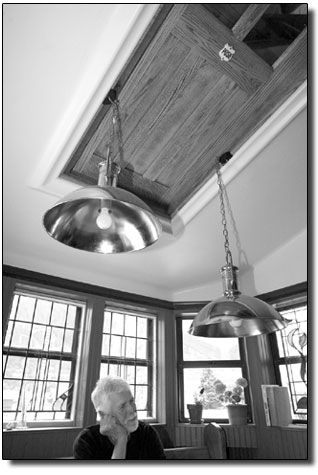|
| ||||
| Recycled residence
by Shawna Bethell
“I’d met Ram Dass in Philadelphia and learned about that subtle letting go, surviving instead of accomplishing,” Myers says. Up until then, Myers, who completed coursework for a PhD in psychology, said he’d failed at every career he tried and found himself apathetic toward his work. “So, I left the corporate world and my second wife. I was kind of making my last stand,” he recalls. He headed west and soon found himself in Silverton, where, for $4,500, he bought a house slated for the burn pile. Instead, the house, originally built in 1904, became an ongoing collage of Myers’ collectibles, inspiring artists and homeowners alike. Old doors and leaded windows, chair backs and ornate moldings, nautical lamps and various Buddhas all utilized in ways that engage the eye, but are chosen foremost for function. Some consider the house an artistic work in progress, an Alice in Wonderland, down the rabbit hole experience, but the tall, white-haired, self-proclaimed hermit scratches his head and denies any artistic intent. “I am a collector of things,” he says. “I bought a house with no things, not even doors or windows. It is just a sense of putting the things together.” With such a variety of “things,” the house could have become a hodge-podge of knick-knacks, but Myers has an eye for both function and form. In the bright kitchen, smooth lines create the contour of his kitchen table and the counter island, both hand-crafted. But the contemporary lines stop there. An old, refinished church pew sits beneath a south-facing window, triangular in shape with curved sides. Myers explains it was not a desire for originality or art that created the shape, it was simply utility. The curves sweep away from the doorway and allow entrance to the long seat against the wall. Mine pipe with welded metal spiraling its length serves as a table leg, and two brass antique nautical lamps hang over the seating area, upstaged only by the refinished door set into the ceiling. “I’d planned to have a sky-light there,” Myers explains nonchalantly of the first “rabbit hole” characteristic of the home. “But I couldn’t find a window in my collection that suited it. But this door was beautiful and fit perfectly into the space.” Victorian moldings, small windows and shelves grace the walls. Each finely crafted cubby hole engages the eye. Bright paint of gold, green, purple and red accentuate the textures of each piece.
Myers credits Handmade Houses: A Guide to the Wood Butcher’s Art as his woodworking teacher. “I didn’t know you could do this type of thing without being taught or spending years working under a wood craftsman. But I read this book and it opened everything up. Besides, I was here in the sticks, and no one really cared what you were doing.” Other rooms replicate the creative assemblage of the kitchen. One room with a raised and built-in ship-like berth is finished with the panels of 20 different doors. A small cubby inset frames a trefoil design that came off a side of a pump organ in a civil war church in Indiana. “I can’t make anything that neat … so I thought I’d better have it,” said the collector waving toward the piece. It is finished with a richly colored, wooden checkerboard at its base. “I can’t make drawer things either,” he says later, touring a barn full of items. “I can’t make chairs. I collect them instead for when I need them.” Myers says he has probably 60 doors and 40 light fixtures. The barn is full of shapes, from the antique to the whimsical. “If I see a shape I’d like to live with, I bring it home.” But Myers specifies he does not like to duplicate things. He does not buy in pairs and if he has a pair, he sells one. “This barn was so full you couldn’t walk through it,” he says. “So a few years ago I had a sale. I made $17,000. Didn’t have to work again for awhile.” Myers is a carpenter, regardless of his modesty, and worked the mines as well. When he feels like he needs a break, he heads to a Buddhist monastery or someplace to meditate and work on mindfulness. He recently spent time in Nova Scotia at a Tibetan Monastery directed by Pema Chodron. “She talks about her teacher and his philosophy on things that stop the mind, on things experienced with no preconceived notion,” he says. “I’d never thought of it this way, but it is kind of why I do the unexpected here, like the door in the ceiling. It is an element out of the ordinary.” Myers has one room left to finish in his functional work of art, then says his collecting days are over, but as the house has thus far taken 30 years of improvement and remains a work in progress, it doesn’t look like that will be any time soon. •
|



 Thirty years ago, give or take a year, Dale Myers (aka Timberline) arrived in Silverton with a van full of woodworking tools and no knowledge of how to use them.
Thirty years ago, give or take a year, Dale Myers (aka Timberline) arrived in Silverton with a van full of woodworking tools and no knowledge of how to use them.